
|   |

|   |
 e-mail: sunilkothari1933@gmail.com Fourth edition of Navvarsh Dance Festival Photos: Shankar Photography February 6, 2020 Under the aegis of Saraswati Educational Cultural and Charitable Trust and Sri Ganapathi Seva Samiti Temple, Bengaluru, at the temple venue a two day classical dance festival Navvarsh Mahotsav was organized featuring Mohiniattam, Odissi and Sattriya dances on 18th January and Bharatanatyam, Kathakali and Kuchipudi on 19th January. This year, the trustees honoured Kathak exponent Shovana Narayan, Kathakali Guru FACT Padmanabhan and Guru Rangashree Srinivasan. 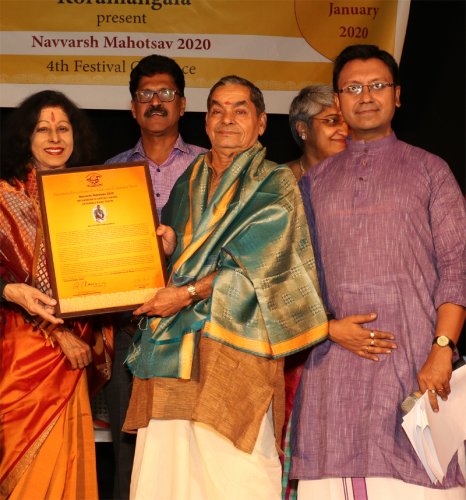 Shovana Narayan, FACT Padmanabhan, Prabal Gupta 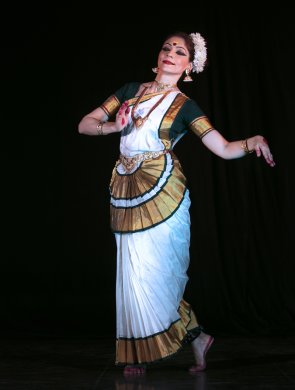 Vani Bhalla Pahwa From New Delhi, Vani Bhalla Pahwa presented few select items choreographed by her Guru Bharati Shivaji. The opening item was a prayer in praise of Lord Ganapati and Goddess Saraswati. It was interesting to watch the concept of Sopana through the sequence and anecdote of emergence of Lord Ganesha. In the midst of an ocean of milk is a golden tree, beneath which is a golden platform, upon which rests another platform, adorned with silk fabric. This fabric is sprinkled with holy rice, on which is the mouse upon which is seated Lord Ganesha, who is the darling son of Lord Shiva and Parvati. Vani evoked this anecdote in a graphic manner. Ritualistic in nature, it was imbued with poetry. I had not seen this aspect in Mohiniattam, and enjoyed its descriptive aspect. After this Vandana, Vani depicted prayer in praise of Goddess Saraswati. The item was set to Arabhi raga and tala chempada. Mukhachalam is a nritta item with a variety of Mohiniattam movements. The choreography with Sopanam music in Ragamalika consisted of Begada, Saveri, and Desakhi ragas. The andolita, swaying movement and drawing the curve while moving backward on either side with each leg were graceful. Vani with her tall, slim frame moved at leisurely pace. What was interesting was her abhinaya to a padam set in Kedara raga and chempada tala, in which a maiden wakes up and is wonderstruck having seen a handsome man in her dream. She is overcome by shyness and wonders while sharing her dream with her friends who that handsome man could be. Could he be Kamadeva? But he is anang, formless and the man she dreamt of had a radiant face and royal demeanor. Could he be Lord Shiva? But the man in her dream did not have a third eye. Or perhaps he could have been Indra! But no, Indra was cursed and had numerous eyes on his body. The man in her dream was having eyes, feet, lips, face like lotus. Then he must be Abjanabha. She looks in various directions with a hope to find him. Vani expressed these images and her wonderment, eloquently. Vani has shown promise under training and guidance of Bharati Shivaji.With more experience and performances, she will acquire maturity. Bangalore based Sarita Mishra has made quite a name as a prominent Odissi dancer. She has been running her Odissi institution for more than a decade in Bangalore and is organizing annual dance festivals. Her performances are marked by elegance and typical Odissi flavour. She presented Guru Kelucharan Mohapatra's choreography of Shankarabharanam Pallavi set to music by Bhubaneswar Mishra. This Pallavi has an eternal appeal. I have watched it for more than 40 years and still its appeal has remained everlasting. Sarita's presentation was joyous and in keeping with the graceful movements that stood out for their inherent beauty and imagination with which Kelubabu has invested the pallavi. Her dance was abundant and subtle neck and eye movement to the melody of the music were attractive. She possesses attractive stage presence. Her body falls into sculpturesque poses and the resolutions of the movements are perfect. The Navarasa abhinaya number, which she studied under Guru Gangadhar Pradhan, displayed her command over the nine sentiments. Gangadhar Pradhan has based it upon incidents of the Ramayana. Therefore it gives scope for display of each of the eight sentiments. Shringara was displayed when while playing in the garden, Sita's eyes meet with Rama. While moving on bank of Godavari river, the sentiment of love is aroused in Sita seeing the handsome and beautiful Lord Rama and similar feelings are aroused in Rama watching Sita. Veera was depicted by showing Rama lifting the bow of Lord Shiva during the swayamvara of Sita. When Ravana came to kidnap Sita in guise of a mendicant seeking alms, when Sita crosses the three lines Lakshmana had drawn, and he reveals to her his original form, Sita is afraid. Bhayam was demonstrated with that episode. When a wounded Jatayu offers pranams, Lord Rama is overcome with compassion, Karuna, for him. When the two brothers reject the demon Shurpanakha in turns, and Lakshmana cut off her nose and ears, thereby disfiguring her, that causes laughter, Hasya. Impersonating the characters of Rama, Lakshmana and Shurpanakha, Sarita etched them distinctly. For the Adbhuta rasa, Guru Gangadhar Pradhan had selected the sequence of setubandhana. For Raudra the most cherished scene for any choreographer is the duel between Rama and Ravana. The manner in which a dancer depicts the shooting of arrows and displays fierce expressions on the face is a testimony of her ability to register bhavas conveying the mood and sentiment. Watching on battlefield the birds hovering over dead bodies of the fallen soldiers, the entire scene arouses disgust, Bibhatsa. The final sentiment of Shanta is generated while meditating with concentration on the lord. The entire choreography leads in the end to Shanta rasa. Sarita did justice to all the nine sentiments succinctly. 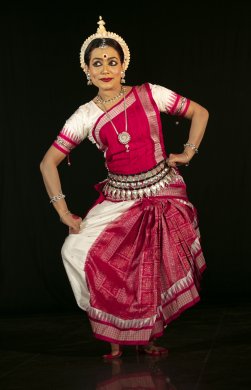 Sarita Mishra 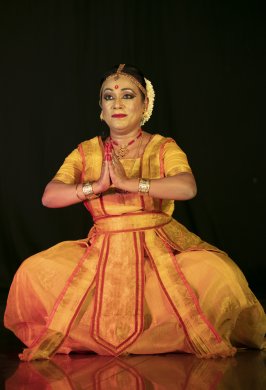 Anita Sharma The last presentation was of Sattriya dances of Assam by the renowned Assamese exponent Anita Sharma with her daughter Arhie Kaushik from Guwahati. Trained by Guru Jatin Goswami, Anita Sharma has mastered the form well both in nritta and abhinaya. Of late, Sattriya dances are often presented in Bangalore. Only a few days ago, I had seen Anita Sharma performing in Drishti Festival. For Navavarsha festival, she had selected Sankaradeva's prayer in praise of Lord Krishna. The Sanskrit poem with epithets like Kanja lochana, lotus like eyes, Mahabahu, the grand form, decorated in Pitambara, various ornaments, navanita chora, fond of butter, Nandatmaja, son of Nandarai, in nutshell creates images of Lord Krishna with various typical hastas of Sattriya dances. The devotional nature of the item is seen in restrained expressions. And the description of Krishna's divine form is realized by the dancer enacting his beautiful form. Both mother and daughter performed it in unison gracefully. Trained by Anita and Guru Jatin Goswami, Arhie Kaushik is fast developing into a fine dancer. Chali dances are choreographed with variety of movements and are often performed with a song known as Gitor nach. The special mnemonics of khol with unusual texture and different talas show the special movements of mati akhadas, physical exercises, metamorphosed in nritta. The chuta tala, eka tali and other talas lend charm and variety in execution of the nritta number. The most dramatic work was Daksha Yagna .When Sati visits her father Daksha's Yagna, she sees various gods including Brahma being seated in the Sabha, but not her husband Shiva. She is pained and bows to her father, who ignores her. She is deeply hurt and humiliated. Unable to bear the insult, she jumps into the fire and immolates herself. On learning about Sati's jumping into fire, Lord Shiva arrives and picks up the body of Sati and destroys the Yagna. Guru Jatin Goswami has choreographed the incident with dramatic elements. Sati's character as enacted by Anita is deeply moving. She uses a scarf to differentiate the characters, which is a traditional mode. The use of large cymbals and drums enhanced the dramatic effect. Anita wears expressions of unhappiness, surprise, insult, humiliation in most communicative manner. It is one of her favourite items. I am glad she presented the Anikya Nat, with dramatic element of Sattriya dances, familiarizing the audience with the larger corpus of dance-drama form of Sattriya dances. On second evening of the festival, Sai Venkatesh was honoured for his excellence in lighting. The artist for the opening number was renowned Bharatanatyam exponent Soundarya Igoor, disciple of Guru Narmada with excellent Pandanallur bani. She is currently learning under B Bhanumati. Very few people know that Soundarya has an excellent academic career. She earned her Ph D in Dance for the topic relating to classical dance in Indian cinema under the guidance of Dr. Nagesh V Bettakote. Currently she is teaching Bharatanatyam at the Dept of Performing Arts at Jain University. An exquisite dancer, Soundarya's exposition is marked by nritta and communicative abhinaya. With a stately stage presence she engages attention of her audience the moment she enters the stage. There is a sense of dignity and serenity in her approach. She presented the celebrated kriti of Saint Thyagaraja depicting the key incidents from Ramayana. In Jagadanandakaaraka set to raga Naatai and adi tala she brought to the fore, the divinity of Lord Rama, alternating with captivating nritta and abhinaya. As lord Rama wielding the bow and blessing his devotees, Soundarya invested the form of Lord Rama, holding the bow in various ways. He is, as Thyagaraja describes, Janaki prananayaka, the beloved of Janaki. The Sita swayamvara incident had dramatic approach. The incident of Ahalya uddhar was indicative of Rama's compassion. Cursed to become a stone by her suspicious husband sage Gautama, Ahalya at the touch of Rama's feet comes back to life. The refrain of Janaki prananayaka is repeated to sing glory of Rama. Soundarya's abhinaya, as wronged but innocent Ahalya, was touching. The anger of Gautama rishi and his cursing Ahalya were shown fleetingly. Bharata's placing Rama's paduka on his head and worshipping them was another moving episode. The utter devotion for brother Rama came in sharp focus both in singing and abhinaya. The interesting sequence was of Setubandhana. Inviting the monkeys to lift the stones throwing them into the ocean, Hanuman writes name of Rama on the stones and lo and behold, they float in the water and form the bridge. The great devotion of Hanuman was danced with imagination. The final duel between Rama and Ravana created the impact suggesting victory of good over evil. Soundarya has excellent ability to lift the kriti to higher aesthetic level with bhakti, while dancing as a devotee of Lord Rama. Thyagaraja's kriti finds a felicitous expression in her abhinaya. Ashtapadi from Gita Govinda in Dwijavanti raga and mishra chapu tala dwelt upon Krishna's request to Radha to be united when he invites her, meaning now. She seems to be angry with Krishna. When Krishna offers her flower she ignores him. Krishna prepares bed with kisalaya flowers, and requests Radha to place her lotus feet on the bed. He invites her by offering the anklets which he would place on her feet. Krishna's plea through his soft words that his lips are seeking adhara rasa is ignored by Radha. He tells her that without her his life is as good as without prana, lifeless. He is suffering the pangs of separation. Radha's not responding puts Krishna in a state of utter despair. He turns away from Radha and after a while he feels someone touching him. He is overjoyed. He asks Radha to place her feet on his lap and he ties anklets to her feet. He places his palm on his head and tells Radha to leave anger and be pleased. The ashtapadi ends in a delightful mood when they are seen together. The expressions of helplessness, utter disappointment, of begging Radha to reconcile, et al, were beautifully expressed. Tillana in Hindolam raga and khanda eka tala with Vaidyanatha Bhagavatar's prayer in praise of Kamakshi towards end saw Soundarya in fine form. Her stances were perfect, with pauses of silence, drew attention to sculpturesque postures that she struck. Graceful, retreating steps and holding arms upward were engaging visuals. She invested Bharatanatyam form with majesty. Here is a dancer who with her art elevates the audiences to higher aesthetic level. Srivatsa, Soundarya's husband on vocal, Sheela Chandrasekhar on nattuvangam, Harsha Samaga on mridangam and Kartik Satavalli on flute provided ideal accompaniment. 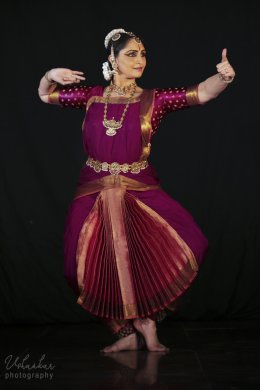 Soundarya Igoor 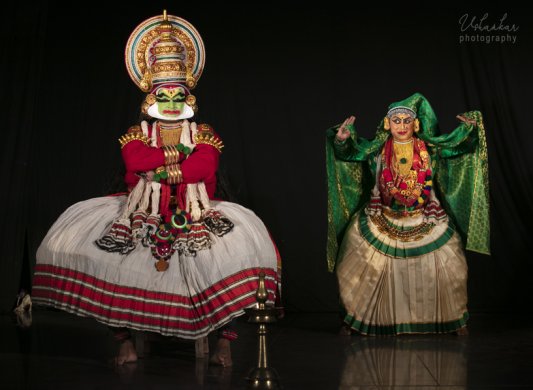 Sadanam Vipin Chandra & Prabal Gupta From the younger generation among Kathakali dancers, Prabal Gupta's name is to be reckoned with. Trained under gurus like Sadanam Balakrishnan and FACT Padmanabhan, he is equally conversant with Purusha vesham and stree vesham. He continues to do research and practice under Sadanam Balakrishnan. He had selected a sequence from Kalakeya Vadham wherein Urvashi is smitten by love seeing Arjuna's beauty. Arjuna had saved Urvashi from Vajrabahu and Vajraketu. When Arjuna was alone, she made advances towards him beseeching his love and physical union. Prabal is gifted with a pair of eyes which are more eloquent than even the sahitya sung by the musicians, to which a Kathakali actor enacts abhinaya. The playwright Kottyam Tampuran has employed several similes and metaphors to depict the attraction Urvashi feels for handsome Arjuna. She tells him that seeing his royal stature and valour she is overcome with a tremendous desire to be with hm. Kamadeva has been shooting arrows which has further placed her in a sad state. She wants him to kiss her with his red lips. The way Prabal expressed these emotions with his large eyes were marvelous. Kathakali is known as a theatre of imagination. A Kathakali actor can improvise and make the presentation more enjoyable. Arjuna is shocked at Urvashi's demands. He tells her that a lady of such celestial beauty must not fall for a mere mortal like him. He gives examples saying swan eats lotus and not the stem, an elephant falls in love with another elephant and not a deer. Similarly she should seek a handsome celestial being befitting her heavenly beauty and not him. Urvashi counters his statements saying his own mother Kunti had surrendered to Surya when a virgin and then she enjoyed relationship with his own son Yama. Is he not son of that lady Kunti? Arjuna refutes saying that having married King Pururava, Urvashi was like a mother to him and it is improper to have any union between them. Enraged, Urvashi tells him that being a friend of Krishna and one who has fought with even Lord Shiva, has his heart turned into stone that he has no pity on her? She curses Arjuna that for rejecting her, he would turn into a eunuch. Prabal had expressions of intense attraction for handsome Arjuna - played with dignity by young Sadanam Vipin Chandra from Sadanam Kathakali Academy from Pallakad - at his beck and call. He danced kalasam, nritta sequences with grace and when reverted back to abhinaya, his face became the playground of various emotions. The purusha vesham by Sadanam Vipin Chandra with full make up and aharya was impressive. Prabal managed to contain a lot in a brief duration of twenty minutes. He used excellent recorded music in place of live orchestra, which otherwise would be not only very difficult to invite from Kerala but also very expensive. Even when there was a glitch, as often happens in technology, repeating performance and starting again, did not detract attention of the audience. 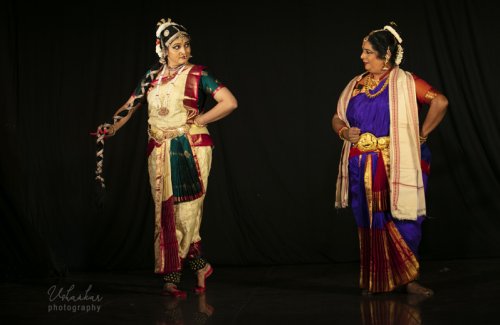 Shama Krishna & Veena Murthy Vijay Trained by Veena Murthy Vijay in Kuchipudi, the moment Shama Krishna as Satyabhama in Pravesha Daru entered the stage with her allure and charm befitting a swadhinapatika, proud and favourite queen of Krishna, showed that with natural gifts, beauty, she can invest her performance with charms of Satyabhama, boasting about her birth, as a daughter of King Satrajit. The song Bhamane, Satyabhamane set the tone of the Bhama Kalapam. The story is well known about quarrel between Krishna and Satyabhama. When looking into the mirror, to tease Satyabhama, Krishna asks her between the two of them who is more beautiful. Proud and vain, Satyabhama declared herself as superior in beauty to Krishna. At that Krishna took offence and left her palace. Repenting for her mistake Satyabhama realized that she had erred. She recounts the incident to her confidante Madhavi. In a mischievous mood, Madhavi questions who she is referring to? Satyabhama begs of her to go to Krishna and asking his forgiveness bring him back to her. In traditional dance-drama in Kuchipudi, there are interesting interpolations with vachikabhinaya in Telugu between Satyabhama and Madhavi. Madhavi feigns ignorance and asks who she is referring to as her husband. Satyabhama tell her as per the Hindu tradition, how can she say her husband's name. Madhavi asks what his attributes are. When Satyabhama describes him as having chakra, Madhavi laughs and asks is he a potter? He wears peacock feather. Oh, is he a forest dweller? And so on the repartee continues. Then Madhavi puts one more condition, to give her nose ring. Satyabhama promises to give necklaces, bangles, diamond rings, all her wealth but not the nose ring which is her emblem as a wife of her lord. Finally she parts with the nose ring. The dialogue between them was much enjoyed by the audience. Veena Murthy as Madhavi did a superb job with her histrionic abilities. Finally Madhavi tellls Satyabhama to write a letter which she agrees to carry to Krishna. Finest among Telugu literature, the Patralekha sequence beginning with poetic word Srimadratnakarputrika, its several similes, description of wealth, hansatulika, the bed on which she was seated with Lord Krishna, studded with rubies, diamonds, and when Krishna left her, how she was miserable and could not bear the sounds of birds. She taunted Krishna as stone hearted, going to co-wife Rukmini, and left her suffering. Removing her tears, she signs as 'your loving Satya' and gives the letter to Madhavi. Then the song describing her separation, Kamadeva shooting arrows with five flowers highlighting it with quick silver foot work, Shama Krishna evoked her agony artistically. The traditional blaming Kamadeva, Manmathadushanam, and the moon Chandradushanam were performed with intensity. Seeing her state, Madhavi hastens to go to Krishna. Overjoyed, Satyabhama and Madhavi look up for the auspicious signs, 'Shukanalu manchi vare Amma.' Seeing Brahmins going to temple for worship et al, Madhavi moves on. Satyabhama looks in the direction in which Madhavi departs. The entire presentation by Shama Krishna and Veena Murthy Vijay was highly entertaining. The presentation had old world charm, proving that when enacted as per the tradition, its appeal is universal. Veena Murthy Vijay is known for adhering to tradition and maintaining the spirit. Together, a talented disciple and a seasoned guru kept the audience in thrall. The finale was Simhanandini, the old form of temple dance, a combination of dancing and drawing with feet on a canvas on the floor, the design of a lion to the Simhanandini tala with its variegated elements, talas, shlokas, recitation of the mnemonic syllables. Dancing on the floor on which yellow powder was spread, Veena Murthy Vijay expertly drew the image of a lion to thunderous applause from the audience. This is a rare tradition maintained by C.R. Acharyalu and other gurus which Veena Murthy Vijay has inherited and preserved. No wonder the captive audience gave the artistes a standing ovation.  Dr. Sunil Kothari is a dance historian, scholar, author and critic, Padma Shri awardee and fellow, Sangeet Natak Akademi. Dance Critics' Association, New York, has honoured him with Lifetime Achievement award. Post your comments Please provide your name and email id when you use the Anonymous profile in the blog to post a comment. All appropriate comments posted with name and email id in the blog will also be featured in the site. |